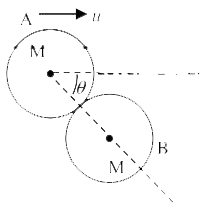A moving ball of mass m undergoes a head - on elastic collision with another ball of mass 2 m at rest .Show that the colliding ball loses 89th of its K.E. energy after collision.Solution in Punjabi
1/9 of its initial kinetic energy
1/4 of its initial knetic energy
1/2 of its initial kinetic energy
8/9 of its initial kinetic energy.
Step by step video & image solution for A moving ball of mass m undergoes a head - on elastic collision with another ball of mass 2 m at rest .Show that the colliding ball loses 8/9 th of its K.E. energy after collision. by Physics experts to help you in doubts & scoring excellent marks in Class 11 exams.
Updated on:21/07/2023Topper's Solved these Questions
Similar Questions
What is SI unit of work?
View SolutionWhich state of matter has the greatest and least internal enrgy having the same mass and same temperature?
View SolutionA ball of mass 'm' moving with speed 'u' undergoes a head-on elastic collision with a ball of mass 'nm' initially at rest. Find the fraction of the incident energy transferred to the second ball.
View SolutionA ball 'A' of mass 'm' moving along positive x-direction with kinetic energy K and linear momentum "p" undergoes elastic head on collision with a stationary ball 'B' of mass M . After the collision, the ball A moves along negative x-direction with kinetic energy K//9 , the final linear momentum of the ball B is
View SolutionA ball of mass m moving with velocity u strikes another identical ball at rest. Find the velocities of the balls after the collision if the coefficient of restitution is e and the collision is head -on. Also , calculate the loss in K.E.
View SolutionA ball of mass m moving with a velocity v undergoes an oblique elastic collision with another ball of the same mass m but at rest. After the collision if the two balls move with the same speeds , the angle between their directions of motion will be:
View SolutionA billiard ball of mass M , moving with velocity v1 collides with another ball of the same mass but at rest . If the collision is elastic , the angle of divergence after the collision is
View SolutionA billiard ball of mass M , moving with velocity v1 collides with another ball of the same mass but at rest . If the collision is elastic , the angle of divergence after the collision is
View SolutionA ball of mass m moving with a velocity collides head on elastically with another of the same mass m but moving with a - in the opposite direction). After the collision
View SolutionA ball A of mass M collides elastically with a similar ball B at rest as shown in figure. Initially velocity of ball A is u m/s. After collision,
View SolutionA ball moving with speed u collides with an identical ball at rest. The velocities of two balls after collision are (If the collision is elastic):
View Solutionनियत वेग u से गतिमान m द्रव्यमान की एक गेंद एक अन्य ऐसी गेंद से टकराती है जो विरामावस्था में है। यदि e प्रत्यवस्थान गुणांक है तो संघट्ट (Collision) के पश्चात् दोनों गेंदों के वेगों का अनुपात होगा-
View SolutionA billiard ball of mass M , moving with velocity v1 collides with another ball of the same mass but at rest . If the collision is elastic , the angle of divergence after the collision is
View SolutionA ball of mass m moving with velocity v collides head on elastically with another identical ball moving with velocity - V. After collision
View SolutionA ball of mass m moving with velocity v collides head on elastically with another identical ball moving with velocity - V. After collision
View SolutionA ball A of mass M collides elastically with a similar ball B at rest as shown in figure. Initially velocity of ball A is u m/s. After collision,

View Solution
